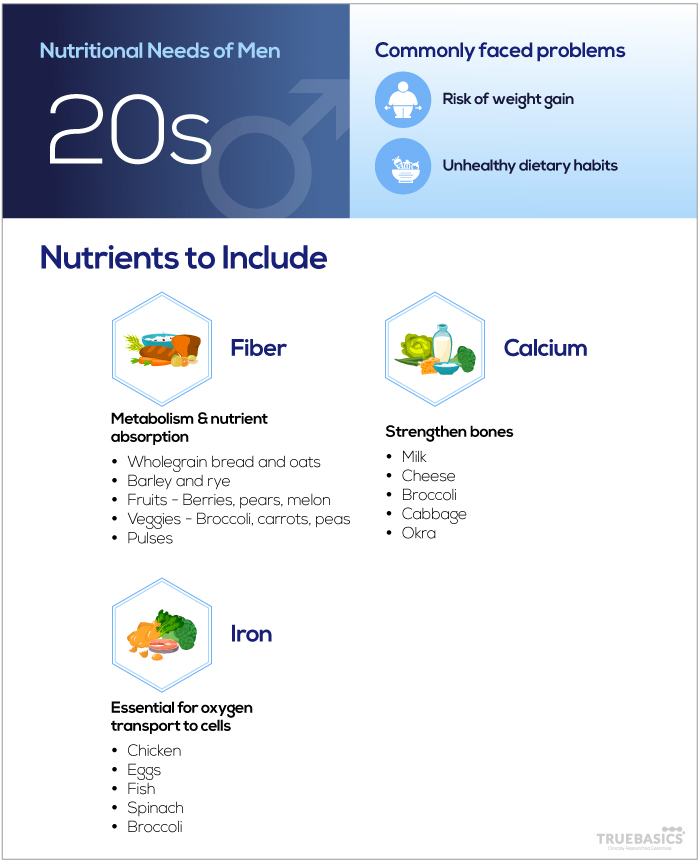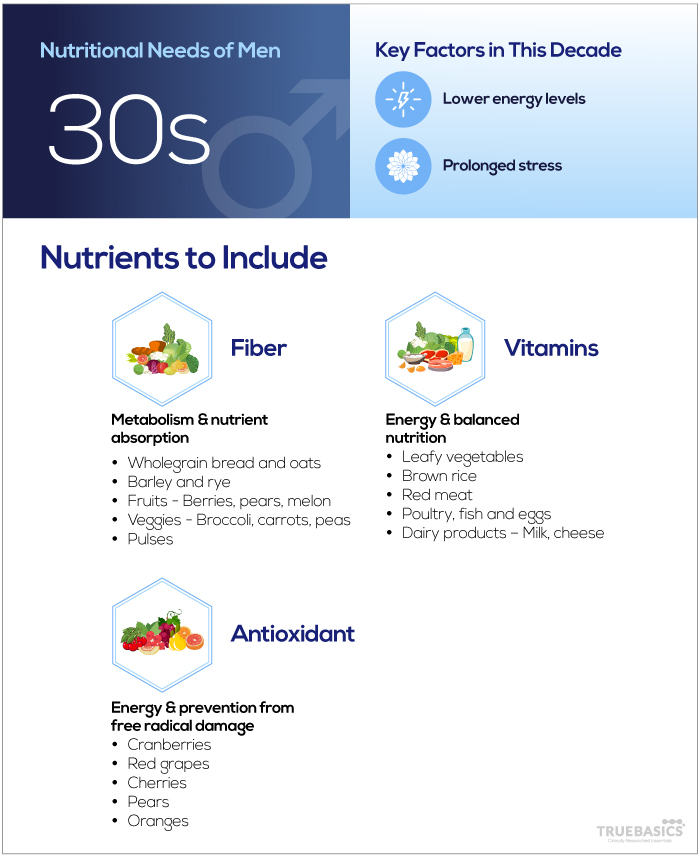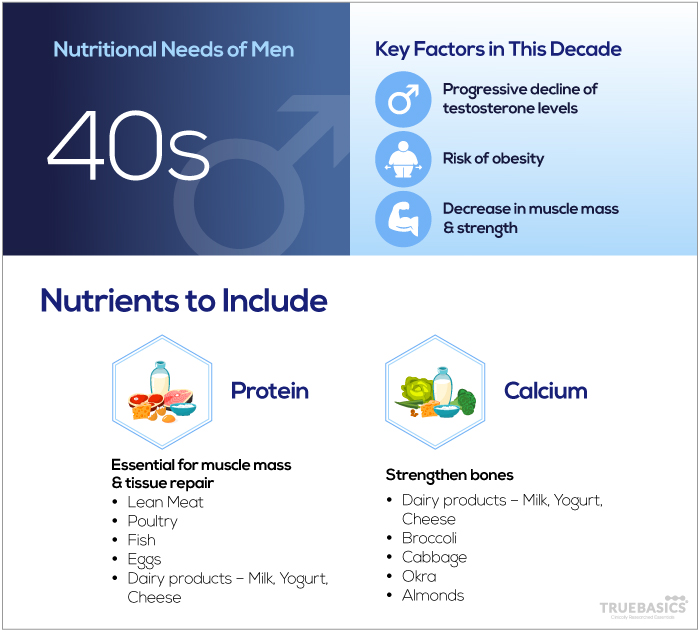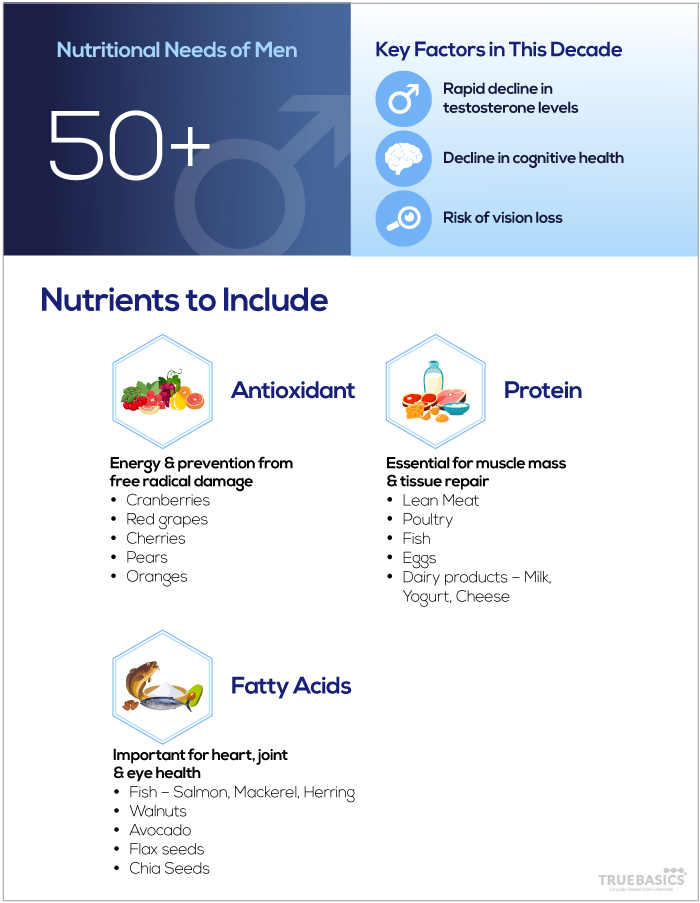Staying healthy and eating right is very important for us, irrespective of our age. We know the mantra that a balanced diet is a healthy way of life. However, our body’s nutritional needs differ with age and gender.
Our body undergoes drastic changes with age, making it important for us to take note of adequate consumption levels of Vitamins and Minerals required for complete nutrition. Furthermore, a healthy diet for a man is different from a healthy diet for a woman. It is important for men of all ages to know their specific nutritional needs as they age to ensure a healthy life.
Here is how Men’s nutritional needs change with age –
In your 20s
Young adults are vulnerable to weight gain due to change in their dietary patterns like breakfast skipping, eating outside the home and consuming fast food regularly. Meals and snacks prepared outside the home contain more calories and are higher in total fat and saturated fat that may induce obesity.
Young adults, in their 20s, consume approximately 40% of their total daily energy away from home which has a considerable impact on overall dietary quality. Fast foods are lower in dietary fiber, Calcium, and Iron than home-made foods. In addition, Calcium and Iron are important elements during this period of development for an increase in lean body mass and skeletal growth. Enough fiber in the diet can prevent obesity by preventing excessive food intake and fat accumulation.
Therefore, healthy dietary behaviors are needed that can prevent the risk of obesity and overcome the nutritional deficiencies due to increased intake of junk food by this age group.
Include these foods in your diet to harness your #TruePotential:
- Fiber
Fiber is important for metabolism and nutrient absorption.
Food Sources: Wholegrain bread and oats, barley and rye, fruits such as berries, pears, melon, and oranges. Vegetables such as broccoli, carrots and sweetcorn, peas, beans, and pulses. - Calcium
Calcium helps to strengthen bones.
Food Sources: Milk, cheese, and other dairy foods, broccoli, cabbage, and okra.
- Iron
Iron is an integral part of hemoglobin which is essential for oxygen transport to cells and the production of red blood cells.
Food Sources: Animal-based foods are the best source of Iron, especially red meat. Chicken, eggs, fish, spinach, and broccoli are also a good source of Iron

In your 30s
Some of the most common complaints of men in their 30s are decreased stamina, lower energy levels, and unexplained weight gain. Stress is often a persistent presence for this age group. Stress coupled with a lack of physical activity is associated with low energy and stamina.
In addition, stress, unhealthy diets, and smoking also induce obesity in this age group. A fiber-rich diet is required to control obesity, while energy booster nutrients like TrueBasics Multivitamin and minerals, Omega-3 fatty acids, antioxidants rich fruits are required to maintain high energy levels and stamina.
Include these foods in your diet to harness your #TruePotential:
- Fiber
Fiber is important for metabolism and nutrient absorption.
Food Sources: Wholegrain bread and oats, barley and rye, fruits such as berries, pears, melon, and oranges. Vegetables such as broccoli, carrots and sweetcorn, peas, beans, and pulses.
- Vitamins
Vitamins play several roles in the body including providing energy, bolstering immunity, repair cellular damage, and convert food into energy.
Food Sources: Leafy vegetables, brown rice, red meat, poultry, fish, eggs, milk, cheese, beans
- Antioxidant
Antioxidants help in energy production and prevention from free radical damage.
Food Sources: Cranberries, red grapes, cherries, pears, guava, oranges, etc.

In your 40s
Beginning around the age of late 30s to early 40s, testosterone levels in men decrease by 1% to 3% per year. Decreasing levels of testosterone over time can lead to a decrease in lean muscle mass and muscle strength leading to decreased physical activity, higher fall risk, and obesity.
Adequate consumption of dietary protein is critical for the maintenance of optimal muscle health. In addition, bone mineral density decreases with the decline of testosterone that may lead to osteopenia and osteoporosis. Thus, Calcium-rich diets or Calcium supplements are required to counter testosterone-induced low bone mass density.
Include these foods in your diet to harness your #TruePotential:
- Protein
Proteins are essential for muscle mass and tissue repair.
Food Sources: Lean meat, poultry, and fish, eggs, dairy products like milk, yogurt, and cheese, pulses are the good sources of protein.
- Calcium
Calcium is the principal mineral that strengthens bones and is very important to prevent bone loss due to a decline in estrogen.
Food Sources: milk, cheese, and other dairy foods, broccoli, cabbage, and okra.

Beyond your 50s
The rapid decline in testosterone levels after the 50s often causes loss of muscle mass leading to reduced muscle strength.
Studies have reported that the volume and weight of the brain decline with age at a rate of around 5% per decade after the age of 40 [1]. These changes in the brain may affect cognitive functions.
Diets rich in polyunsaturated fatty acids (PUFA) play multiple roles in improving brain function by influencing neurotransmission, cell survival, and neuroprotection.
Additionally, in people aged over 50, age-related macular degeneration (AMD) is the leading cause of irreversible vision loss. Dietary antioxidants are found to be beneficial in decreasing the risk of age-related eye disease.
Include these foods in your diet to harness your #TruePotential:
- Antioxidant
Antioxidants help in energy production and prevention from free radical damage.
Food Sources: Cranberries, red grapes, cherries, pears, guava, oranges, etc. - Protein
Proteins are essential for muscle mass and tissue repair.
Food Sources: Lean meat, poultry, and fish, eggs, dairy products like milk, yogurt, and cheese, pulses are the good sources of protein. - Fatty Acids
Fatty acids play an important role in maintaining heart, joint, and eye health.
Food Sources: Sunflower seeds, Flax seeds, Fish, such as salmon, mackerel, herring, albacore, Walnuts, Avocado, Chia seeds.

In Conclusion…
A healthy diet is required to meet the changing nutritional needs of different age groups.
Young adults are vulnerable to weight gain due to the change in their dietary patterns. In addition, Calcium and Iron are important elements during this period of development for an increase in lean body mass and skeletal growth.
Adequate consumption of dietary protein and Calcium is critical for the maintenance of optimal muscle and bone health in the 30s and 40s.
The rapid decline in testosterone levels after the 50s may be associated with rapid loss of muscle mass leading to reduced muscle strength. In addition, age-related eye disease and impaired cognitive functions are highly prevalent after the 50s. Diets rich in PUFA such as Omega-3 play multiple roles in improving heart, joint, and eye health while dietary antioxidants are found to be beneficial in decreasing the risk of age-related eye disease. Body nutrition requirements change with age, lifestyle and dietary habits. Adjustments in the diet and nutrition are necessary for each phase of life for healthy ageing.
#ShareIfYouCare #RepublicofDeficiency
Sources:
[1] Svennerholm L, Boström K, Jungbjer B. Changes in weight and compositions of major membrane components of the human brain during the span of adult human life of Swedes. Acta Neuropathol 199794345–352













